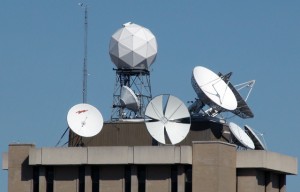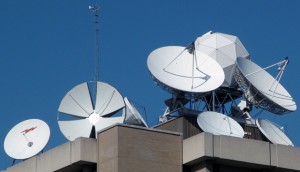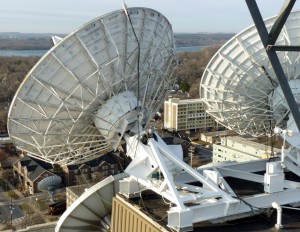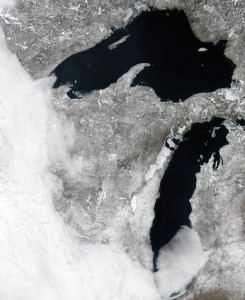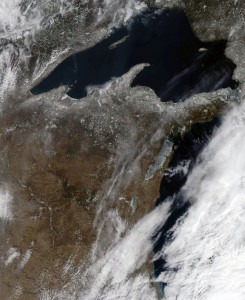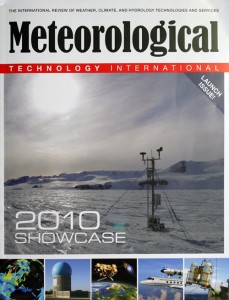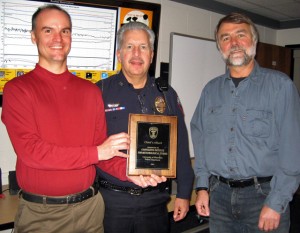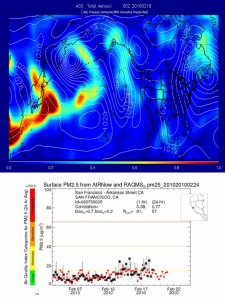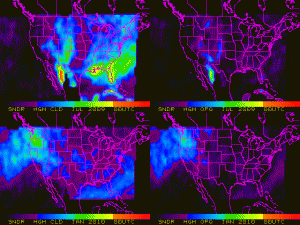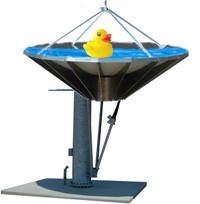Monthly News Summary – April 2010
- New “Kid” on the Block
- NASA Compliments SSEC’s Atmosphere PEATE
- Weather Guys Find New Outlet
- Now You See It, Now You Don’t!
- AMRC Featured in New Publication
- UW-Madison Police Honor CIMSS
- RAQMS CalNex Global Chemical and Aerosol Forecasts Available On-line
- CIMSS Satellite Blog Showcasing GOES-13 During Eclipse Outage
- Manuscript on Upper Tropospheric Storm Signatures from Advanced IR Sounder Submitted
- Monthly Average of Cloud Frequency from the GOES Sounder
- New Dish Supplies Center With Long-Awaited Spa
A new Patriot 6.3 meter diameter C-Band receiving antenna is the latest addition to the array of dishes mounted on the roof of the Atmospheric, Oceanic, and Space Sciences Building on the UW-Madison campus.
The Patriot 6.3 meter dish, with panels still to be attached, at bottom center.
This antenna will serve as a back-up to either of our other two C-Band antennas: the 7.3 meter “West Dish,” now looking at the AMC2 communications satellite to receive data relayed from MTSAT-1R, POES (Gilmore Relay), and NOAAport; and the 11 meter “Orchard Street Dish,” now pointed to the AMC3 communications satellite to receive data relayed from MSG Meteosat-9 and POES (Wallops Relay).
The 7.3 meter “West Dish,” shown here above and to the right of the new dish, on the penthouse roof.
Looking past the two 7.3 meter dishes mounted on the penthouse, down to the 11 meter “Orchard Street Dish.”
The new antenna will be heated to keep it free of snow, a big advantage over the existing West Dish that needs to have snow removed by hand to receive a proper signal. Snow can keep the West Dish down for several days in the winter because safe hand removal requires calm conditions after a snowfall.
Further assembly, such as adding the final four panels of the dish and installing the drive motors and data feed system, will take place over the next few weeks.
The SSEC “Spotlight” page has videos and a slideshow of the massive crane hoisting the new equipment 16 stories to the roof of the AOSS building.
NASA Compliments SSEC’s Atmosphere PEATE
In a message relayed through Liam Gumley at SSEC, Bob Schweiss, NPP Science Data Segment Manager at NASA Goddard Space Flight Center, complimented SSEC’s Atmosphere PEATE team on its efforts during the recent NPP Ground Segment Integration Test (GSIT).
One of six Product Evaluation and Algorithm Test Elements (PEATE) supporting the NPP mission, SSEC hosts the only PEATE not at a NASA center. The Atmosphere PEATE supports the NPP Science Team’s evaluation of data quality by providing multiyear comparisons for quantitative product validation with spaceborne and ground-based data sources. SSEC staff supporting the GSIT were Scott Mindock, Roseann Spangler, Janean Hill, Douglas Ratcliff, Jordan Walker, Tommy Jasmin, and Ethan Kellogg.
Schweiss went on to say that the Atmosphere PEATE participation in the GSIT test was viewed very positively by the folks in Washington. In particular he singled out Scott Mindock for his tireless and professional support of the countless hours of teleconferences, documentation reviews, and procedures testing leading up to the GSIT.
Jonathan Martin and Steve Ackerman, collectively known as “The Weather Guys,” are the hot new item on “The Why Files,” a Web site that covers the science lurking behind the headlines.
As described in a recent UW press release, the Weather Guys use the public’s nearly universal fascination with weather as an opportunity to “show how science works.” The Guys have already made their name on call-in radio and with a column in the Wisconsin State Journal. Going online with the Why Files gives the Guys another avenue for exploring the methods and mechanisms of weather.
Now You See It, Now You Don’t!
When the clouds lifted on March 14th, SSEC’s MODIS-Today imagery captured a scene that falls in stark contrast to the last clear “winter” day only six days before (March 8th).
Before (March 8th Aqua) – After (March 14th Aqua):
Catalog of the past 30 days’ images showing the dramatic change in snow cover.
Submitted by Dr. Sam Batzli, WisconsinView Director
AMRC Featured in New Publication
The premiere issue of “Meteorological Technology International,” a recently launched international journal of weather, climate, and hydrology technologies and services, features an extensive article authored by Matthew Lazzara outlining both the history and the current work of the UW Antarctic Meteorological Research Center (AMRC).
The cover image for the journal is one of the 63 Automatic Weather Stations currently maintained and operated by the AMRC in Antarctica.
On March 19, Assistant Chief Dale G. Burke of the UW-Madison Police Department presented CIMSS with the 2009 University of Wisconsin Police Department Community Service Award for Providing Weather Forecasts for Special Events in Camp Randall Stadium.
Photo by Maria Vasys
Tom Achtor and Wayne Feltz accepted the award for all of the CIMSS employees and grad students who participated in the forecasting efforts. CIMSS has been providing this service since 2002.
RAQMS CalNex Global Chemical and Aerosol Forecasts Available On-line
Global Real-time Air Quality Modeling System (RAQMS) chemical and aerosol forecasts in support of the upcoming NOAA CalNex field mission are now available on-line.
The RAQMS 2×2 degree 72 hour forecasts are initialized with real-time assimilation of cloud-cleared total column ozone from the Ozone Monitoring Instrument (OMI), stratospheric ozone profiles from the Microwave Limb Sounder (MLS) onboard the NASA Aura satellite, and aerosol optical depth (AOD) from the Moderate Resolution Imaging Spectroradiometer (MODIS).
Forecasts are being evaluated with measurements of surface ozone and aerosols from the U.S. Environmental Protection Agency (EPA) AIRNow network in preparation for the CalNex mission. The RAQMS forecasts will be provided to forecasters at the California Air Resources Board (CARB) in support of operational decisions for the CalNex measurement platforms. RAQMS forecasts will also be delivered to CARB air quality modelers in real-time to provide lateral boundary conditions for CalNex regional model forecasting activities.
RAQMS Aerosol Optical Depth (AOD) prediction (upper panel) valid at 00Z on February 19, 2010 showing the transport of enhanced aerosol loading arriving onshore in Northern California associated with trans-pacific transport of Asian pollution. The enhanced AOD (~0.3) is found ahead of a strong low pressure system over the Eastern Pacific. AOD is indicated by colored shading and sea-level pressure (mb) is indicated by white contours. The lower panel shows a real-time comparison with US EPA AIRNow fine (<2.5 micron) particulate matter (PM2.5) observations (black) and RAQMS PM2.5 predictions (red) (micro-grams/cubic meter). Good agreement at the San Francisco monitoring station indicating that the RAQMS forecasts can provide useful information regarding trans-pacific transport of aerosol pollution for CalNex flight planning activities.
Submitted by Brad Pierce
CIMSS Satellite Blog Showcasing GOES-13 During Eclipse Outage
A recent Cooperative Institute for Meteorological Satellite Studies (CIMSS) satellite blog entry included images from the Geostationary Operational Environmental Satellite (GOES)-13 Sounder and other sensors/products.
The animations showcased the benefits of operation through eclipse for a recent convective case. The improved image quality of GOES-13, due to the colder detectors, is also demonstrated, as well as the nearcasting predictions of precipitable water differences product. More information is posted at http://cimss.ssec.wisc.edu/goes/blog/archives/4777 and http://cimss.ssec.wisc.edu/goes/blog/wp-content/uploads/2010/03/Sounder_6.5_loop.gif.
Manuscript on Upper Tropospheric Storm Signatures from Advanced IR Sounder Submitted
A manuscript titled “The Upper Tropospheric Signatures of Storms from Hyperspectral Resolution Infrared Soundings” has been submitted to Geophysical Research Letters. The study reveals the upper tropospheric stability from high accuracy and fine vertical resolution high spectral resolution infrared soundings, in conjunction with heavy precipitation, which may provide an explanation of unknown storm initiation mechanisms. Co-authors are Chian-Yi Liu, Jun Li and Steve Ackerman (CIMSS).
Monthly Average of Cloud Frequency from the GOES Sounder
Since July 2009, the average diurnal frequency of cloudiness has been calculated using the Geostationary Operational Environmental Satellite (GOES) Sounder data at the Cooperative Institute for Meteorological Satellite Studies (CIMSS).
For each month average hourly frequency of cloudiness for all clouds, Low-, Mid-, and High-level clouds are determined at a one degree latitude/longitude resolution. For the High-level clouds additional frequencies for thin, thick, and opaque clouds are determined over the GOES Sounder area coverage. Currently only monthly diurnal frequency averages are being determined, but this can be changed to weekly or even annual frequencies, if desired.
Monthly average diurnal (hourly) frequency of all high clouds (left) and high opaque clouds (right) for July 2009 (top) and January 2010 (bottom). The total range of the color bar is from 0% to 100% with the three break points of the color bar representing 25% (magenta/blue), 50% (cyan/green), and 75% (yellow/orange). Note the strong diurnal signal in July compared to January.
New Dish Supplies Center With Long-Awaited Spa
As of April 1, 2010, installers of the new 6.3 meter satellite dish have nearly completed the last steps of gearing the low-torque precision motors and attaching the plumbing necessary to create a large, solar-heated spa. With the parabolic antenna horizontally positioned, and the retractable thin black polymer coating in place, all that is needed is to pump water into the dish. After approximately 75 minutes (slightly longer on a partly cloudy day), solar energy will heat the water to a comfortable 40.5 degrees Celsius (105 degrees F). The utility hoist will supply easy access to the soothing waters.
Popularity of the dish/spa will determine whether or not a sign-up sheet will be required to ensure that all will have their “time in the sun.” Although the Data Center warns that signal degradation is almost inevitable when the dish is in “Spa orientation,” those soaking in the bowl will enjoy a spectacular panoramic view. Because we are on University property, proper bathing attire is required.

